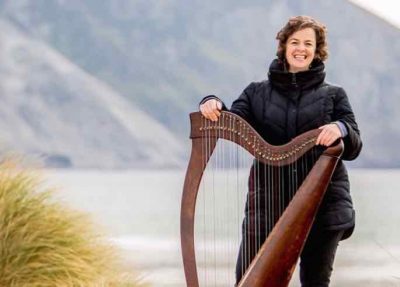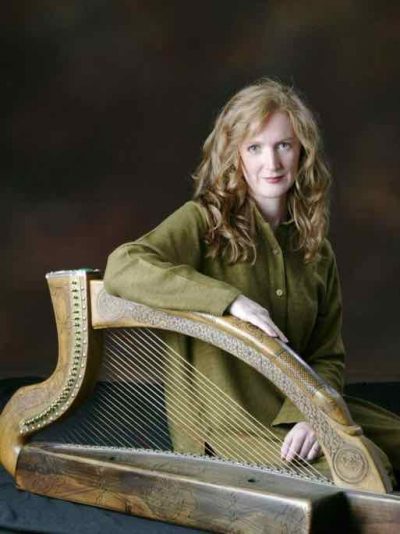Music is a deep part of life and history in Ireland.. It makes sense then that a well known symbol of the country is a musical instrument: the harp.

The instrument turns up on euro coins of Ireland, on official documents, on passports, as part of logos of companies from breweries to airlines, in medieval manuscripts, and in the shape of a bridge in Dublin designed in its honor.
Harps are often thought of as providing background music for weddings and as part of orchestral performance. They certainly may be found in those places in Ireland.
The harp in Ireland is very much a living instrument in other ways.
The musicians who choose to play this instrument have many ideas. Siobhán Armstrong, Moya Brennan, and Laoise Kelly focus their playing in varied ways.
Hear different aspects of Ireland and its stories as you learn about the music these three musicians create.
Moya Brennan grew up in a musical household and in a place where music is vibrant in the community. Her family band, Clannad, has a distinctive sound which draws on Irish tradition, and especially the sounds of their native Donegal in the far northwest of the island. They have long drawn on influences of myth, legend, and the rugged landscape of their home place to create their music. The result is a haunting sound which draws on tradition while moving it forward.
Moya’s voice and her playing are part of this. She’s brought these creative skills to her solo career, too, bringing this approach to traditional music and applying it to music by contemporary songwriters also. In a more directly traditional vein Brennan has joined up with three long time Donegal friends Maighread Ní Dhomhnaill, Tríona Ní Dhomhnaill, and Mairead Ni Mhaonaigh to form the supergroup T with the Maggies, in which her playing and singing gifts are also in evidence.
Laoise Kelly comes from Mayo in Ireland’s west, a bit south of Brennan’s native Donegal. In her work you will hear the rhythms of traditional dance music. Until recently a percussive touch on the harp has not been not all that common a thing in Ireland.

Kelly is a composer, having created music for film and festivals as well as for her own recordings. Kelly is also in demand as a collaborator, working with Monaghan piper Tiarnán Ó Duinchinn and Gaelic singer Kathleen MacInnes from Scotland among others, and as a member of the groups The Bumblebees and Fiddletree. Her creative sound on the harp is also in demand to back other musicians; she has appeared on more than 50 recordings in that capacity.
In 2019 Laoise Kelly was awarded as Traditional Musician of the Year at the TG4 Gradam Ceoil, a prestigious award recognizing traditional artists in Ireland, and recognizing, too, Kelly’s adventurous way fo taking harp tradition forward.
Siobhán Armstrong is taking tradition forward too. In her case, she is doing that in part by looking back. The harp Armstrong most often plays, for instance, is a a replica of the fourteenth century harp you’d see in the library at Trinity College Dublin. That’s the harp which was used as model for the image which appears on all those euro coins.

As is older tradition, Armstrong’s harp is wire strung, which produces rather different sound than other materials used in contemporary harps. Armstrong has a collection of copies of single and multi-row European harps from the Middle Ages, the Renaissance and the baroque era, which she puts to use in playing music from those periods in a range of settings from opera to orchestra to consort.
As an Irish harpist, Siobhán is particularly interested in encouraging the revival of the early Irish harp. Strung with wire and played in Ireland from at least a thousand years ago, it died out in the early 19th century. To this end, she founded and chairs The Historical Harp Society of Ireland and is the director of the Society’s annual Festival of the early Irish harp.
Siobhán has recorded an album on her replica of the Trinity College harp. It is called Cláirseach na hÉireann: The Harp of Ireland.
Alongside her solo work, Siobhán performs and records fifteenth- to eighteenth-century music with Europe’s historical musicians. From her base in Kilkenny, the Dublin born artist has also begun a project focusing on the music of Ireland during this these periods, working with other musicians to form the group The Irish Consort. Their first recording is called Music, Ireland, and the Sixteenth Century.
You may also find Siobhán bringing her harp to gigging at top traditional music festivals and collaborating with Irish traditional musicians including piper Ronan Browne and sean nos singer Roisin Elsafty.
Stories of the harp wind through Ireland, and stories of Ireland wind through Irish music on the harp. Turlough O’Carolan’s tunes have come down the centuries to be played not only on harps but on fiddle. flute, hammered dulcimer, and other instruments. There’s music older than his to be discovered. There are many fine contemporary players of the harp as well, among them Cormac de Barra, Maire Ni Chathasaigh, Grainne Hambly, and Aine Minogue. The harp flourishes in other countries too, from Scotland to Spain to Paraguay.
At this writing travel to and within the Republic of Ireland and Northern Ireland is under restriction.
Travel through imagination, and music, is not.
Explore the music of Moya Brennan, Laoise Kelly, and Siobhán Armstrong. May their creativity offer you ways to explore Ireland more deeply.
You may also wish to read about exploring Ireland through fiddle flute and guitar, and about hearing Ireland in four voices.
Photographs of Laoise Kelly and Siobhán Armstrong courtesy of the artists, photograph of Laoise Kelly’s hands on harp at Celtic Connections Festival in Glasgow, by Kerry Dexter.
Consider subscribing to our stories through e mail, and connecting with us through your favorite social networks. You will find links to do that in the sidebar — and while you’re at that social network exploring, we invite you to keep up with our adventures by liking the Perceptive Travel Facebook page.
